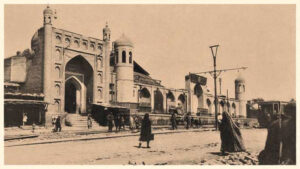SHARE WITH FRIENDS:
-
In the second century BC, the first information about the city appeared in ancient Chinese manuscripts, in various sources it was mentioned as "Shi", "Choch", "Shosh", "Shoshkent", "Binkat", "Tarkan".
-
175-140 BC. The state of Kang, which included Shosh, Khorezm, and Sugdiyana, flourished.
-
AD 712-713 (95 AH). Qutayba ibn Muslim, the leader of Islam, conquered Shosh.
-
819/820 - 855/856 years. Shosh came under the rule of the Samonite dynasty.
-
903–976 years. Abu Bakr ibn Ismail Qaffol Shoshi, a great muhaddith and jurist of Shoshi, lived and created.
-
1036–1144 years. The famous jurist and muhaddith Abu Bakr Muhammad ibn Ahmad Shoshi lived and created.
-
1404 year. Khoja Ahror Vali, a famous mystic and statesman, was born in Shosh.
-
1576 year. Khan of Uzbeks conquered Shosh.
-
1588 year. An uprising against Abdullah Khan broke out in the city.
-
1612–1613. Shosh was conquered by Imam Quli Khan.
-
1723 year. Population and households were registered in Tashkent for the first time in Central Asia.
-
1850 year. Tashkent had 270 neighborhoods, 310 mosques, 17 madrasahs, 11 baths, 15 caravanserais, 11 courtyards and 150 inhabitants.
-
May 1865, 17. Tashkent was occupied by the troops of Tsarist Russia.
-
1866. Engineer M. Kolesnikov first developed the city planning project of Tashkent.
-
1868. The first printing house in Central Asia was established at the district military headquarters in Tashkent.
-
1883. The first printed newspaper in the Uzbek language - "Gazette of the Turkistan Region" - began to be published in Tashkent.
-
June 1892. The uprising of the people of Tashkent known in history as the "Plague Uprising" began.
-
1900 year. The son of Tashkent merchant Tajimuhammad Isomuhammad, who made his first trip to Western Europe, took part in the international exhibition in Paris, and then he visited London.
-
October 1905, 19. Protesters were shot in front of the Tashkent City Duma building.
-
In 1907, there were 23 madrasahs in Tashkent.
-
In 1909, the "Gramofon" company in Riga released the "Iraq", "Nasrulloyi", "Ushshaq" maqams performed by the famous Samarkand hafiz Haji Abdulaziz Rasulov as a separate album.
-
In 1915, the two-volume "History of Turkestan" written by Mulla Olim Makhdumkhoja Tashkenti was published in Tashkent.
-
In 1916, there were popular uprisings against the policy of the Russian tsar in Khojand, Andijan, Margilan, Namangan, Tashkent, Jizzakh.
-
On March 1917, 14, the organization of progressive intellectuals "Shuroi Islamiya" was established under the leadership of Munavvargari Abdurashidkhanov, a famous educator from Tashkent.
-
In 1926, 274 cars and motorcycles were registered in Tashkent.
-
In 1942, Shoahmad Shomahmudov, a blacksmith from Tashkent, and his wife, Bahri Akramova, took care of fourteen children of different nationalities, orphaned by the Second World War.
-
On October 1943, 20, at the congress of representatives of the Muslims of Uzbekistan, Kazakhstan, Kyrgyzstan, Tajikistan, and Turkmenistan, the Central Asian and Kazakh Muslim Religious Control (Office) was established.
-
Since 1953, the five-volume "Russian-Uzbek Dictionary" and the multi-volume "Laws of Medicine" by Abu Ali Ibn Sina have been published in Uzbek and Russian languages.
-
In 1957, Hamroqul Tursunkulov, chairman of the Sharq Yulduzi collective farm in Tashkent region, was awarded the title of Hero of Labor for the third time.
-
In 1958, the famous American black singer Paul Robson gave a concert at the "Pakhtakor" stadium in Tashkent.
-
On April 1966, 26, there was a strong earthquake that caused great destruction in the city of Tashkent.
